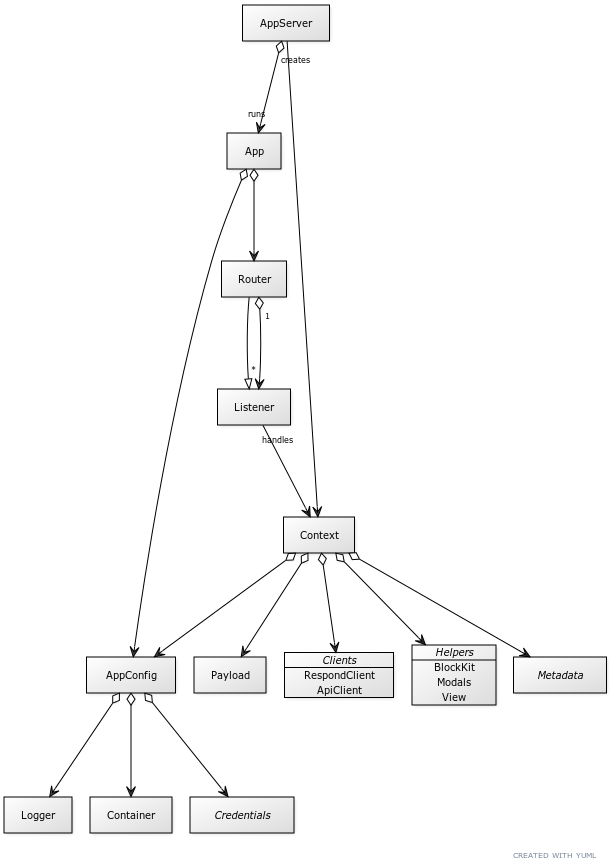A small, PHP framework for building Slack Apps. Takes inspiration from Slack's Bolt frameworks.
This library is only useful if you understand the basics of building Slack applications. Here is some documentation to help you get started there if you are new to Slack app development:
When configuring the app in Slack, you should point all configurable URLs to the root URL of your deployed app code.
When developing the app code, you declare one or more Listeners using the App's routing methods, that correspond to
the different types of app interaction. Listeners can be declared as closures, or as objects and class names of type
SlackPhp\Framework\Listener. A Listener receives a Context object, which contains the payload data provided by
Slack to the app and all the actions you can take to interact with or communicate back to Slack.
This small app responds to the /cool slash command.
<?php
use SlackPhp\Framework\App;
use SlackPhp\Framework\Context;
putenv("SLACK_SIGNING_KEY=blafoobla");
App::new()
->command('cool', function (Context $ctx) {
$ctx->ack(':thumbsup: That is so cool!');
})
->run();The "Hello World" app says hello to you, by utilizing every type of app interactions, including: slash commands, block actions, block suggestions (i.e., options for menus), shortcuts (both global and message level), modals, events, and the app home page.
"Hello World" app code
<?php
declare(strict_types=1);
use SlackPhp\BlockKit\Surfaces\{Message, Modal};
use SlackPhp\Framework\{App, Context, Route};
// Note: Expects SLACK_SIGNING_KEY and SLACK_BOT_TOKEN to be set in environment.
// Helper for creating a modal with the "hello-form" for choosing a greeting.
$createModal = function (): Modal {
return Modal::new()
->title('Choose a Greeting')
->submit('Submit')
->callbackId('hello-form')
->notifyOnClose(true)
->tap(function (Modal $modal) {
$modal->newInput('greeting-block')
->label('Which Greeting?')
->newSelectMenu('greeting')
->forExternalOptions()
->placeholder('Choose a greeting...');
});
};
App::new()
// Handles the `/hello` slash command.
->command('hello', function (Context $ctx) {
$ctx->ack(Message::new()->tap(function (Message $msg) {
$msg->newSection()
->mrkdwnText(':wave: Hello world!')
->newButtonAccessory('open-form')
->text('Choose a Greeting');
}));
})
// Handles the "open-form" button click.
->blockAction('open-form', function (Context $ctx) use ($createModal) {
$ctx->modals()->open($createModal());
})
// Handles when the "greeting" select menu needs its options.
->blockSuggestion('greeting', function (Context $ctx) {
$ctx->options(['Hello', 'Howdy', 'Good Morning', 'Hey']);
})
// Handles when the "hello-form" modal is submitted.
->viewSubmission('hello-form', function (Context $ctx) {
$state = $ctx->payload()->getState();
$greeting = $state->get('greeting-block.greeting.selected_option.value');
$ctx->view()->update(":wave: {$greeting} world!");
})
// Handles when the "hello-form" modal is closed without submitting.
->viewClosed('hello-form', function (Context $ctx) {
$ctx->logger()->notice('User closed hello-form modal early.');
})
// Handles when the "hello-global" global shortcut is triggered from the lightning menu.
->globalShortcut('hello-global', function (Context $ctx) use ($createModal) {
$ctx->modals()->open($createModal());
})
// Handles when the "hello-message" message shortcut is triggered from a message context menu.
->messageShortcut('hello-message', function (Context $ctx) {
$user = $ctx->fmt()->user($ctx->payload()->get('message.user'));
$ctx->say(":wave: Hello {$user}!", null, $ctx->payload()->get('message.ts'));
})
// Handles when the Hello World app "home" is accessed.
->event('app_home_opened', function (Context $ctx) {
$user = $ctx->fmt()->user($ctx->payload()->get('event.user'));
$ctx->home(":wave: Hello {$user}!");
})
// Handles when any public message contains the word "hello".
->event('message', Route::filter(
['event.channel_type' => 'channel', 'event.text' => 'regex:/^.*hello.*$/i'],
function (Context $ctx) {
$user = $ctx->fmt()->user($ctx->payload()->get('event.user'));
$ctx->say(":wave: Hello {$user}!");
})
)
// Run that app to process the incoming Slack request.
->run();You can alternatively create your App and Listeners as a set of classes. I recommend this approach if you have more than a few listeners or if your listeners are complicated. Here is an example of how the "Hello World" app would look when developed in this way.
"Hello World" app code
App.php
<?php
declare(strict_types=1);
namespace MyApp;
use SlackPhp\Framework\{BaseApp, Route, Router};
use MyApp\Listeners;
class MyCoolApp extends BaseApp
{
protected function prepareRouter(Router $router): void
{
$router->command('hello', Listeners\HelloCommand::class)
->blockAction('open-form', Listeners\OpenFormButtonClick::class)
->blockSuggestion('greeting', Listeners\GreetingOptions::class)
->viewSubmission('hello-form', Listeners\FormSubmission::class)
->viewClosed('hello-form', Listeners\FormClosed::class)
->globalShortcut('hello-global', Listeners\HelloGlobalShortcut::class)
->messageShortcut('hello-message', Listeners\HelloMessageShortcut::class)
->event('app_home_opened', Listeners\AppHome::class)
->event('message', Route::filter(
['event.channel_type' => 'channel', 'event.text' => 'regex:/^.*hello.*$/i'],
Listeners\HelloMessage::class
));
}
}index.php
<?php
use MyApp\MyCoolApp;
// Note: Expects SLACK_SIGNING_KEY and SLACK_BOT_TOKEN to be set in environment.
$app = new MyCoolApp();
$app->run();The Context object is the main point of interaction between your app and Slack. Here are all the things you can do
with the Context:
// To respond (ack) to incoming Slack request:
$ctx->ack(Message|array|string|null) // Responds to request with 200 (and optional message)
$ctx->options(OptionList|array|null) // Responds to request with an options list
$ctx->view(): View
->clear() // Responds to modal submission by clearing modal stack
->close() // Responds to modal submission by clearing current modal
->errors(array) // Responds to modal submission by providing form errors
->push(Modal|array|string) // Responds to modal submission by pushing new modal to stack
->update(Modal|array|string) // Responds to modal submission by updating current modal
// To call Slack APIs (to send messages, open/update modals, etc.) after the ack:
$ctx->respond(Message|array|string) // Responds to message. Uses payload.response_url
$ctx->say(Message|array|string) // Responds in channel. Uses API and payload.channel.id
$ctx->modals(): Modals
->open(Modal|array|string) // Opens a modal. Uses API and payload.trigger_id
->push(Modal|array|string) // Pushes a new modal. Uses API and payload.trigger_id
->update(Modal|array|string) // Updates a modal. Uses API and payload.view.id
$ctx->home(AppHome|array|string) // Modifies App Home for user. Uses API and payload.user.id
$ctx->api(string $api, array $params) // Use Slack API client for arbitrary API operations
// Access payload or other contextual data:
$ctx->payload(): Payload // Returns the payload of the incoming request from Slack
$ctx->getAppId(): ?string // Gets the app ID, if it's known
$ctx->get(string): mixed // Gets a value from the context
$ctx->set(string, mixed) // Sets a value in the context
$ctx->isAcknowledged(): bool // Returns true if ack has been sent
$ctx->isDeferred(): bool // Returns true if additional processing will happen after the ack
// Access additional helpers:
$ctx->blocks(): Blocks // Returns a helper for creating Block Kit surfaces
$ctx->fmt(): Formatter // Returns the "mrkdwn" formatting helper for Block Kit text
$ctx->logger(): LoggerInterface // Returns an instance of the configured PSR-3 logger
$ctx->container(): ContainerInterface // Returns an instance of the configured PSR-11 container
YUML Source
[AppServer]<>-runs>[App] [AppServer]creates->[Context] [App]<>->[AppConfig] [App]<>->[Router] [Router]-^[Listener] [Router]<>1-*>[Listener] [Listener]handles->[Context] [Context]<>->[Payload] [Context]<>->[AppConfig] [Context]<>->[_Clients_;RespondClient;ApiClient] [Context]<>->[_Helpers_;BlockKit;Modals;View] [Context]<>->[_Metadata_] [AppConfig]<>->[Logger] [AppConfig]<>->[Container] [AppConfig]<>->[_Credentials_]
- PSR-1, PSR-12: Coding Style
- PSR-3: Logger Interface
- PSR-4: Autoloading
- PSR-7, PSR-15, PSR-17: HTTP
- PSR-11: Container Interface
